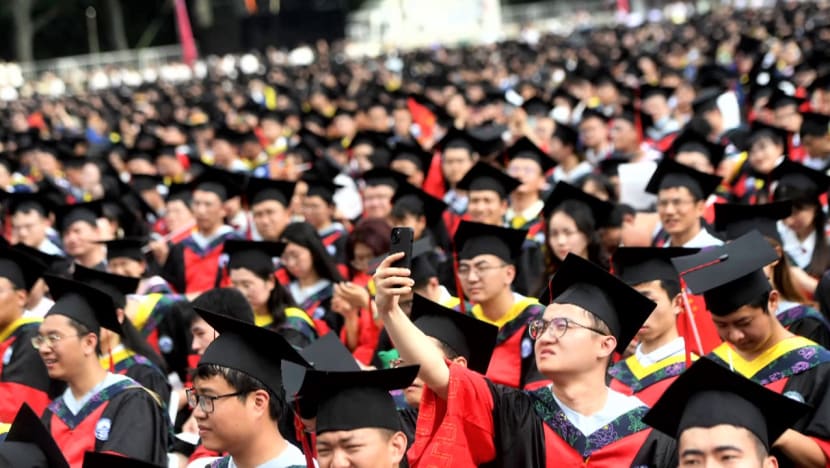Commentary: China grapples with a glut of university-educated workers
China’s surge in colleague graduates has contributed to a supply-demand imbalance in the country’s job market, say researchers from the East Asian Institute, NUS.

SINGAPORE: In mid-July, China reported sluggish quarter-on-quarter growth of 0.8 per cent over April to June, down from 2.2 per cent in the first quarter of 2023.
What is more alarming is that the country’s unemployment rate among 16- to 24-year-olds has reached a record high of 21.3 per cent. This figure is four times higher than the overall urban unemployment of 5.2 per cent, and marks a sixth consecutive increase since January.
The persistent increase in youth unemployment raises grave concerns on the prospect of China’s post-COVID recovery and its economy’s long-term strength.
On Aug 15, the China’s National Bureau of Statistics announced it will suspend publishing data on youth unemployment. Meanwhile, economic indicators in July continued to disappoint.
TRENDS DRIVING YOUTH UNEMPLOYMENT
There have been three major trends in China’s youth unemployment rate in recent years.
First, urban youth unemployment generally moves upward during the first half of the year, reaching its annual peak in July. This corresponds to the end of the school year, when millions of college graduates enter the labour market.
Second, since 2018, youth unemployment jumped several times, most evidently during the first half of the year.

Third, the gap between youth unemployment and unemployment of those aged 25 to 60 has widened significantly, as the latter has remained relatively stable at around 5 per cent. For example, in the second quarter of 2023, youth unemployment rate was 16.7 percentage points higher than those of the older group, up from just 6.1 percentage points in 2019.
What drives this steep climb in youth unemployment, and the widening gap between unemployment rates of different cohorts?
UNPRECEDENTED NUMBER OF COLLEGE GRADUATES
Evidently, poor economic performance during and immediately following the COVID-19 pandemic is an integral factor. Weaknesses in the economy have persisted since March, reflected in decelerating investment growth and factory activity. These result in fewer employment prospects for young job seekers.
This year’s unprecedented number of college graduates adds significant employment pressure. China’s Ministry of Education estimates there will be around 11.6 million college graduates in 2023, 820,000 more than last year.
If 90 per cent of college graduates enter the labour market while the remaining 10 per cent pursue postgraduate studies, like they did in 2022, there will be over 10 million new job entrants, equivalent to about 85 per cent of China’s newly created jobs for the entire year of 2022.
China’s glut of university graduates will likely worsen in the following years. A record high of almost 13 million students attended China’s 2023 college entrance examination, 1 million (8 per cent) more than 2022, which will likely result in a higher number of newly enrolled college students in 2023.
MISMATCH IN CHINA’S JOB MARKET
The significant surge in colleague graduates contributes towards an imbalance between supply and demand in China’s job market.
Regulatory tightening on segments of the economy since 2021 has had a negative impact on youth employment, such as those on the platform sector, for-profit tutoring, and video-gaming.
There has been growing interest to join the public sector through civil service exams, indicating a changing preference for government jobs and a loosening labour market. Indeed, the number of persons aged 35 and below registered for the civil service exam rose from 1.4 million in 2019 to 2.5 million in 2023.
Beyond the above, social change also plays a role in China’s youth employment.
Facing the weakening economy and contracting job market, some Chinese youth have adopted passive lifestyles. They may choose to lie flat (tang ping), let it rot (bai lan), or become full-time children to live with and take care of their parents. Concurrently, some may make efforts to seek employment, take up part-time jobs, or undergo career training.
As these trends become the norm in Chinese cities, there may be more social tolerance for young people who opt out of the competitive job market or the ladder towards professional success. At present, however, the precise impact of such gradual societal changes on youth unemployment is hard to estimate.
GOVERNMENT RESPONSES TO YOUTH UNEMPLOYMENT
Responding to rising youth unemployment, the Chinese government has taken new measures such as providing job opening information online and on-site, training programmes for job-hunting and one-time subsidies to companies that employ new graduates.
Authorities are also promoting self-employment by easing regulations. Some cities, such as Shenzhen, Lanzhou and Hangzhou, have permitted street vendors and hawkers, once banned because they were considered unsightly, to operate in certain areas.
Central and local governments have also hired more college graduates. In 2023, the total recruitment of national civil servants and provincial civil servants will reach nearly 230,000, about a 20 per cent increase from 2020.
Some local governments have also set up local civil servant positions specifically for fresh graduates and relaxed qualifications for them. For example, Shandong Province offered around 1,000 positions reserved for fresh graduates for the first time in 2020.
China’s climbing youth unemployment in recent months shows the complexity in accommodating an increasingly university-educated workforce.
On the one hand, short-term policies are necessary to absorb excess labour supply resulting from the COVID-19 economic downturn. On the other, robust efforts are essential to improve the business environment so that private firms, especially those in up-and-coming industries, may prosper and attract educated youth.
Sarah Y Tong, Li Yao are Senior Research Fellows at the East Asian Institute, National University of Singapore. Dr Zhou Na is Research Fellow at the same institute.






















